Teaching Resources for Early Childhood Education: Literacy and Communication Development
VerifiedAdded on 2023/06/11
|12
|2850
|169
AI Summary
This article discusses effective teaching resources for early childhood education to develop literacy and communication skills among children. It explores five play-based resources for literacy development, including oral language teaching resource, alphabet tracing and writing sheets, sand trays, digital technology teaching resource, and storytelling teaching resource. The article also highlights the concepts and learning outcomes associated with each resource, along with the teaching strategies and activities that can be used to promote literacy development among children.
Contribute Materials
Your contribution can guide someone’s learning journey. Share your
documents today.
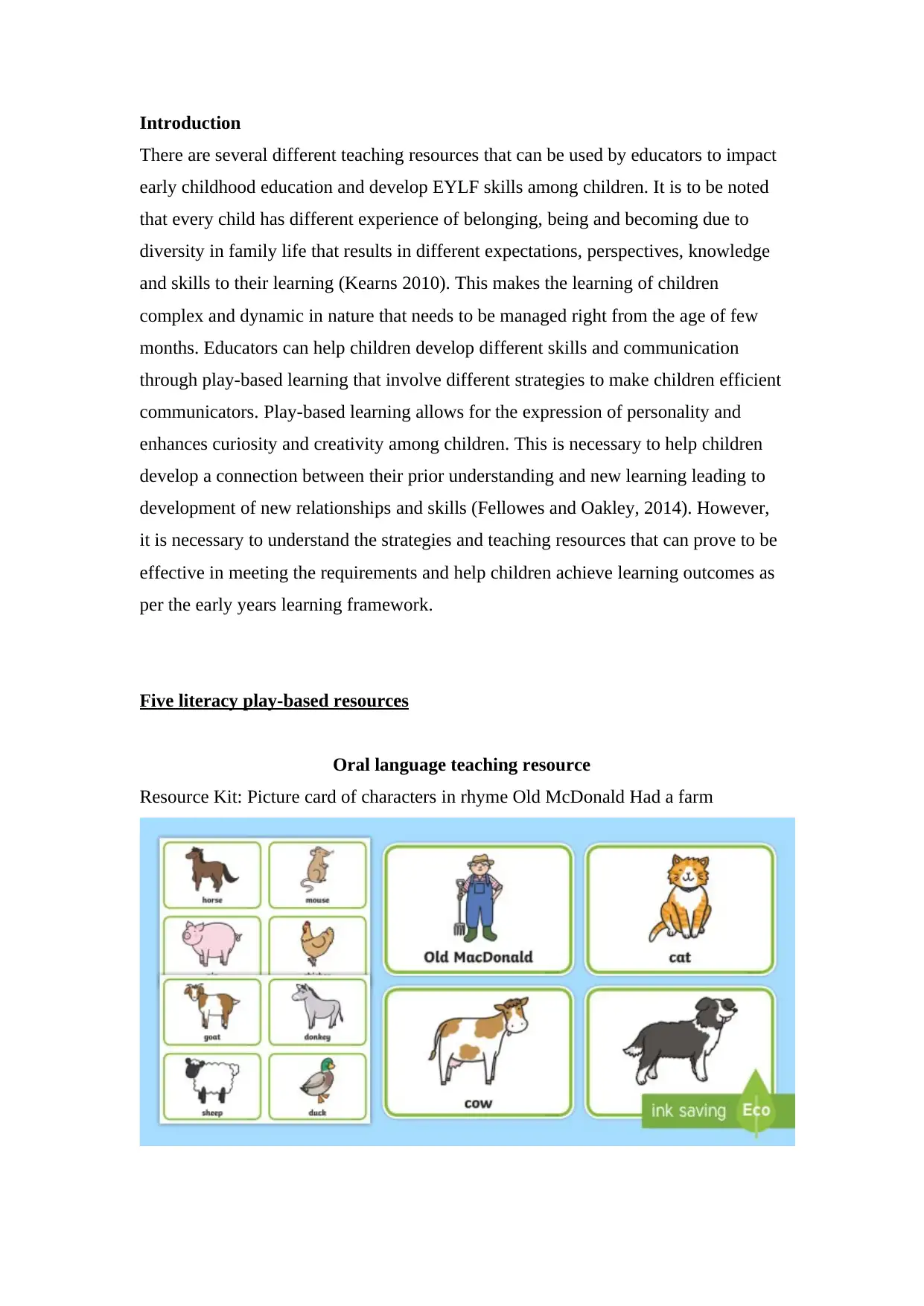
Introduction
There are several different teaching resources that can be used by educators to impact
early childhood education and develop EYLF skills among children. It is to be noted
that every child has different experience of belonging, being and becoming due to
diversity in family life that results in different expectations, perspectives, knowledge
and skills to their learning (Kearns 2010). This makes the learning of children
complex and dynamic in nature that needs to be managed right from the age of few
months. Educators can help children develop different skills and communication
through play-based learning that involve different strategies to make children efficient
communicators. Play-based learning allows for the expression of personality and
enhances curiosity and creativity among children. This is necessary to help children
develop a connection between their prior understanding and new learning leading to
development of new relationships and skills (Fellowes and Oakley, 2014). However,
it is necessary to understand the strategies and teaching resources that can prove to be
effective in meeting the requirements and help children achieve learning outcomes as
per the early years learning framework.
Five literacy play-based resources
Oral language teaching resource
Resource Kit: Picture card of characters in rhyme Old McDonald Had a farm
There are several different teaching resources that can be used by educators to impact
early childhood education and develop EYLF skills among children. It is to be noted
that every child has different experience of belonging, being and becoming due to
diversity in family life that results in different expectations, perspectives, knowledge
and skills to their learning (Kearns 2010). This makes the learning of children
complex and dynamic in nature that needs to be managed right from the age of few
months. Educators can help children develop different skills and communication
through play-based learning that involve different strategies to make children efficient
communicators. Play-based learning allows for the expression of personality and
enhances curiosity and creativity among children. This is necessary to help children
develop a connection between their prior understanding and new learning leading to
development of new relationships and skills (Fellowes and Oakley, 2014). However,
it is necessary to understand the strategies and teaching resources that can prove to be
effective in meeting the requirements and help children achieve learning outcomes as
per the early years learning framework.
Five literacy play-based resources
Oral language teaching resource
Resource Kit: Picture card of characters in rhyme Old McDonald Had a farm
Secure Best Marks with AI Grader
Need help grading? Try our AI Grader for instant feedback on your assignments.
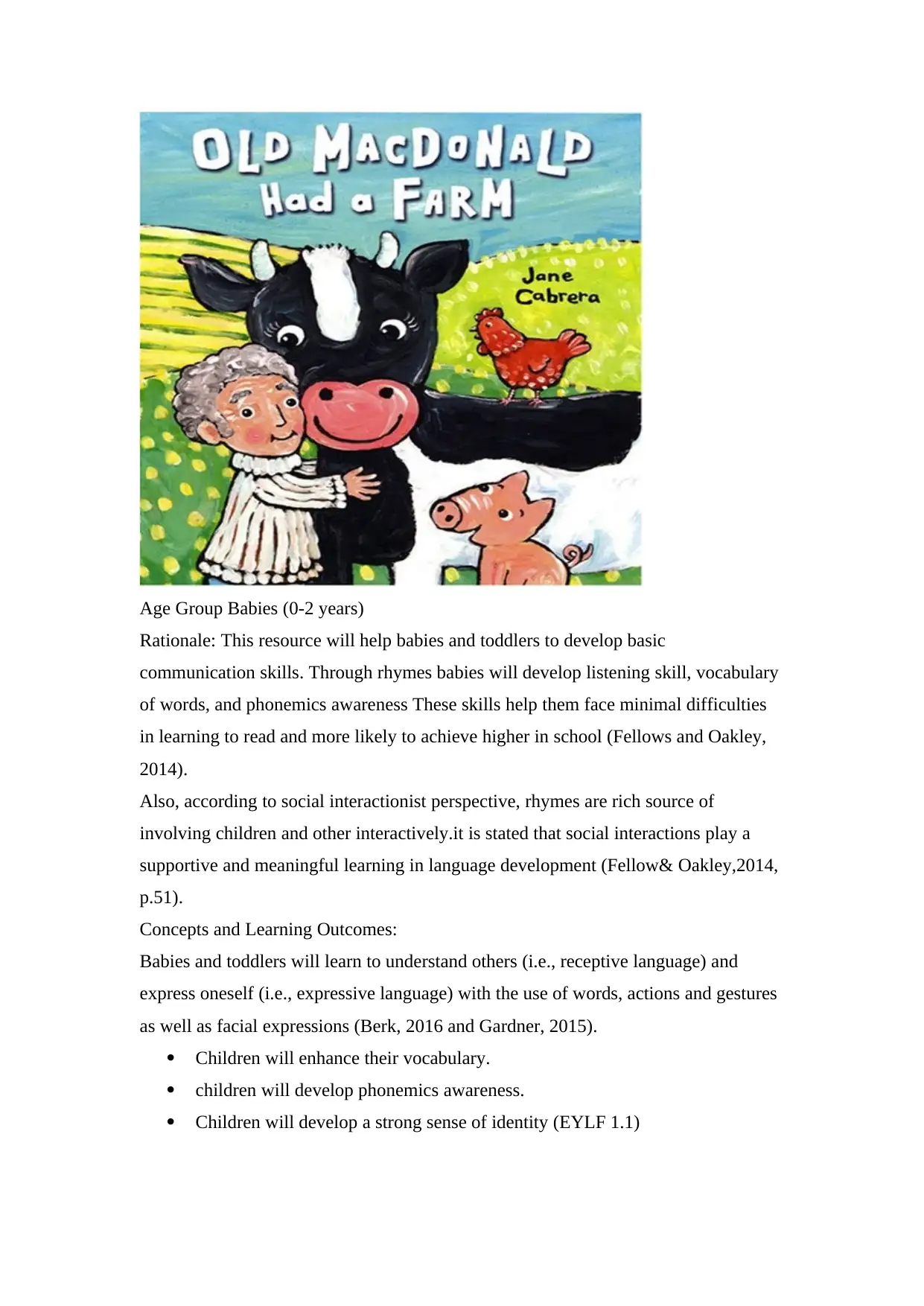
Age Group Babies (0-2 years)
Rationale: This resource will help babies and toddlers to develop basic
communication skills. Through rhymes babies will develop listening skill, vocabulary
of words, and phonemics awareness These skills help them face minimal difficulties
in learning to read and more likely to achieve higher in school (Fellows and Oakley,
2014).
Also, according to social interactionist perspective, rhymes are rich source of
involving children and other interactively.it is stated that social interactions play a
supportive and meaningful learning in language development (Fellow& Oakley,2014,
p.51).
Concepts and Learning Outcomes:
Babies and toddlers will learn to understand others (i.e., receptive language) and
express oneself (i.e., expressive language) with the use of words, actions and gestures
as well as facial expressions (Berk, 2016 and Gardner, 2015).
Children will enhance their vocabulary.
children will develop phonemics awareness.
Children will develop a strong sense of identity (EYLF 1.1)
Rationale: This resource will help babies and toddlers to develop basic
communication skills. Through rhymes babies will develop listening skill, vocabulary
of words, and phonemics awareness These skills help them face minimal difficulties
in learning to read and more likely to achieve higher in school (Fellows and Oakley,
2014).
Also, according to social interactionist perspective, rhymes are rich source of
involving children and other interactively.it is stated that social interactions play a
supportive and meaningful learning in language development (Fellow& Oakley,2014,
p.51).
Concepts and Learning Outcomes:
Babies and toddlers will learn to understand others (i.e., receptive language) and
express oneself (i.e., expressive language) with the use of words, actions and gestures
as well as facial expressions (Berk, 2016 and Gardner, 2015).
Children will enhance their vocabulary.
children will develop phonemics awareness.
Children will develop a strong sense of identity (EYLF 1.1)
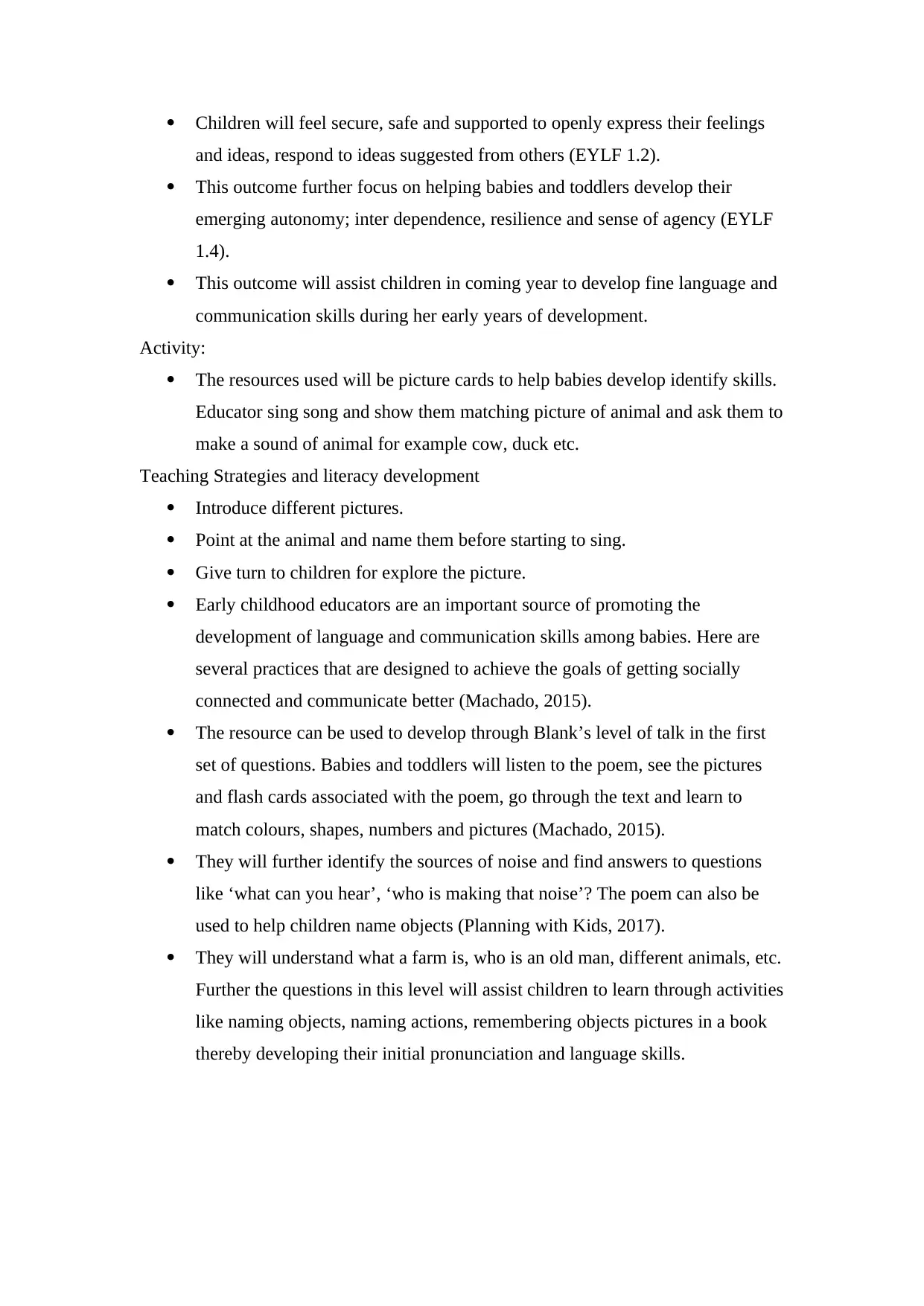
Children will feel secure, safe and supported to openly express their feelings
and ideas, respond to ideas suggested from others (EYLF 1.2).
This outcome further focus on helping babies and toddlers develop their
emerging autonomy; inter dependence, resilience and sense of agency (EYLF
1.4).
This outcome will assist children in coming year to develop fine language and
communication skills during her early years of development.
Activity:
The resources used will be picture cards to help babies develop identify skills.
Educator sing song and show them matching picture of animal and ask them to
make a sound of animal for example cow, duck etc.
Teaching Strategies and literacy development
Introduce different pictures.
Point at the animal and name them before starting to sing.
Give turn to children for explore the picture.
Early childhood educators are an important source of promoting the
development of language and communication skills among babies. Here are
several practices that are designed to achieve the goals of getting socially
connected and communicate better (Machado, 2015).
The resource can be used to develop through Blank’s level of talk in the first
set of questions. Babies and toddlers will listen to the poem, see the pictures
and flash cards associated with the poem, go through the text and learn to
match colours, shapes, numbers and pictures (Machado, 2015).
They will further identify the sources of noise and find answers to questions
like ‘what can you hear’, ‘who is making that noise’? The poem can also be
used to help children name objects (Planning with Kids, 2017).
They will understand what a farm is, who is an old man, different animals, etc.
Further the questions in this level will assist children to learn through activities
like naming objects, naming actions, remembering objects pictures in a book
thereby developing their initial pronunciation and language skills.
and ideas, respond to ideas suggested from others (EYLF 1.2).
This outcome further focus on helping babies and toddlers develop their
emerging autonomy; inter dependence, resilience and sense of agency (EYLF
1.4).
This outcome will assist children in coming year to develop fine language and
communication skills during her early years of development.
Activity:
The resources used will be picture cards to help babies develop identify skills.
Educator sing song and show them matching picture of animal and ask them to
make a sound of animal for example cow, duck etc.
Teaching Strategies and literacy development
Introduce different pictures.
Point at the animal and name them before starting to sing.
Give turn to children for explore the picture.
Early childhood educators are an important source of promoting the
development of language and communication skills among babies. Here are
several practices that are designed to achieve the goals of getting socially
connected and communicate better (Machado, 2015).
The resource can be used to develop through Blank’s level of talk in the first
set of questions. Babies and toddlers will listen to the poem, see the pictures
and flash cards associated with the poem, go through the text and learn to
match colours, shapes, numbers and pictures (Machado, 2015).
They will further identify the sources of noise and find answers to questions
like ‘what can you hear’, ‘who is making that noise’? The poem can also be
used to help children name objects (Planning with Kids, 2017).
They will understand what a farm is, who is an old man, different animals, etc.
Further the questions in this level will assist children to learn through activities
like naming objects, naming actions, remembering objects pictures in a book
thereby developing their initial pronunciation and language skills.
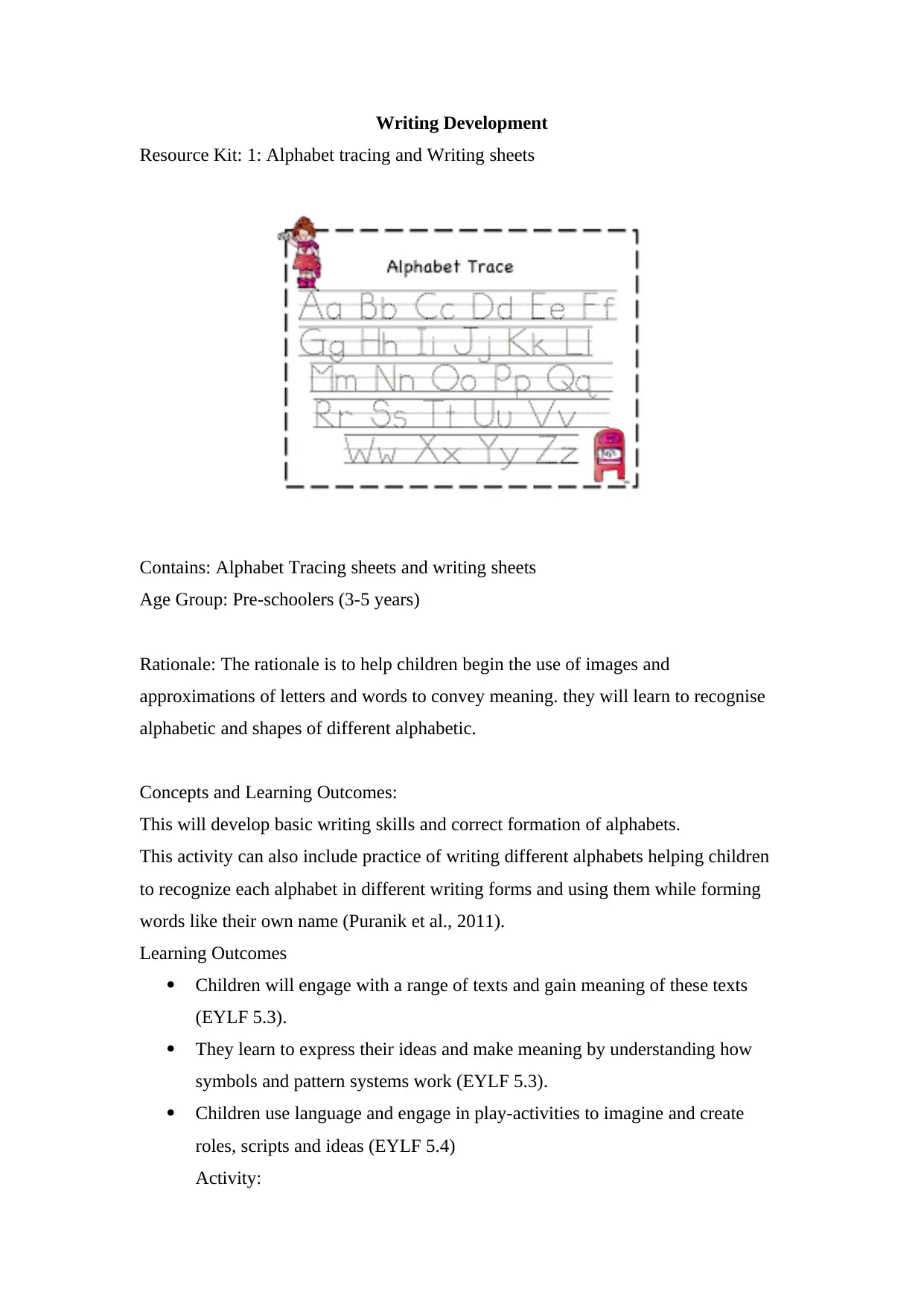
Writing Development
Resource Kit: 1: Alphabet tracing and Writing sheets
Contains: Alphabet Tracing sheets and writing sheets
Age Group: Pre-schoolers (3-5 years)
Rationale: The rationale is to help children begin the use of images and
approximations of letters and words to convey meaning. they will learn to recognise
alphabetic and shapes of different alphabetic.
Concepts and Learning Outcomes:
This will develop basic writing skills and correct formation of alphabets.
This activity can also include practice of writing different alphabets helping children
to recognize each alphabet in different writing forms and using them while forming
words like their own name (Puranik et al., 2011).
Learning Outcomes
Children will engage with a range of texts and gain meaning of these texts
(EYLF 5.3).
They learn to express their ideas and make meaning by understanding how
symbols and pattern systems work (EYLF 5.3).
Children use language and engage in play-activities to imagine and create
roles, scripts and ideas (EYLF 5.4)
Activity:
Resource Kit: 1: Alphabet tracing and Writing sheets
Contains: Alphabet Tracing sheets and writing sheets
Age Group: Pre-schoolers (3-5 years)
Rationale: The rationale is to help children begin the use of images and
approximations of letters and words to convey meaning. they will learn to recognise
alphabetic and shapes of different alphabetic.
Concepts and Learning Outcomes:
This will develop basic writing skills and correct formation of alphabets.
This activity can also include practice of writing different alphabets helping children
to recognize each alphabet in different writing forms and using them while forming
words like their own name (Puranik et al., 2011).
Learning Outcomes
Children will engage with a range of texts and gain meaning of these texts
(EYLF 5.3).
They learn to express their ideas and make meaning by understanding how
symbols and pattern systems work (EYLF 5.3).
Children use language and engage in play-activities to imagine and create
roles, scripts and ideas (EYLF 5.4)
Activity:
Secure Best Marks with AI Grader
Need help grading? Try our AI Grader for instant feedback on your assignments.
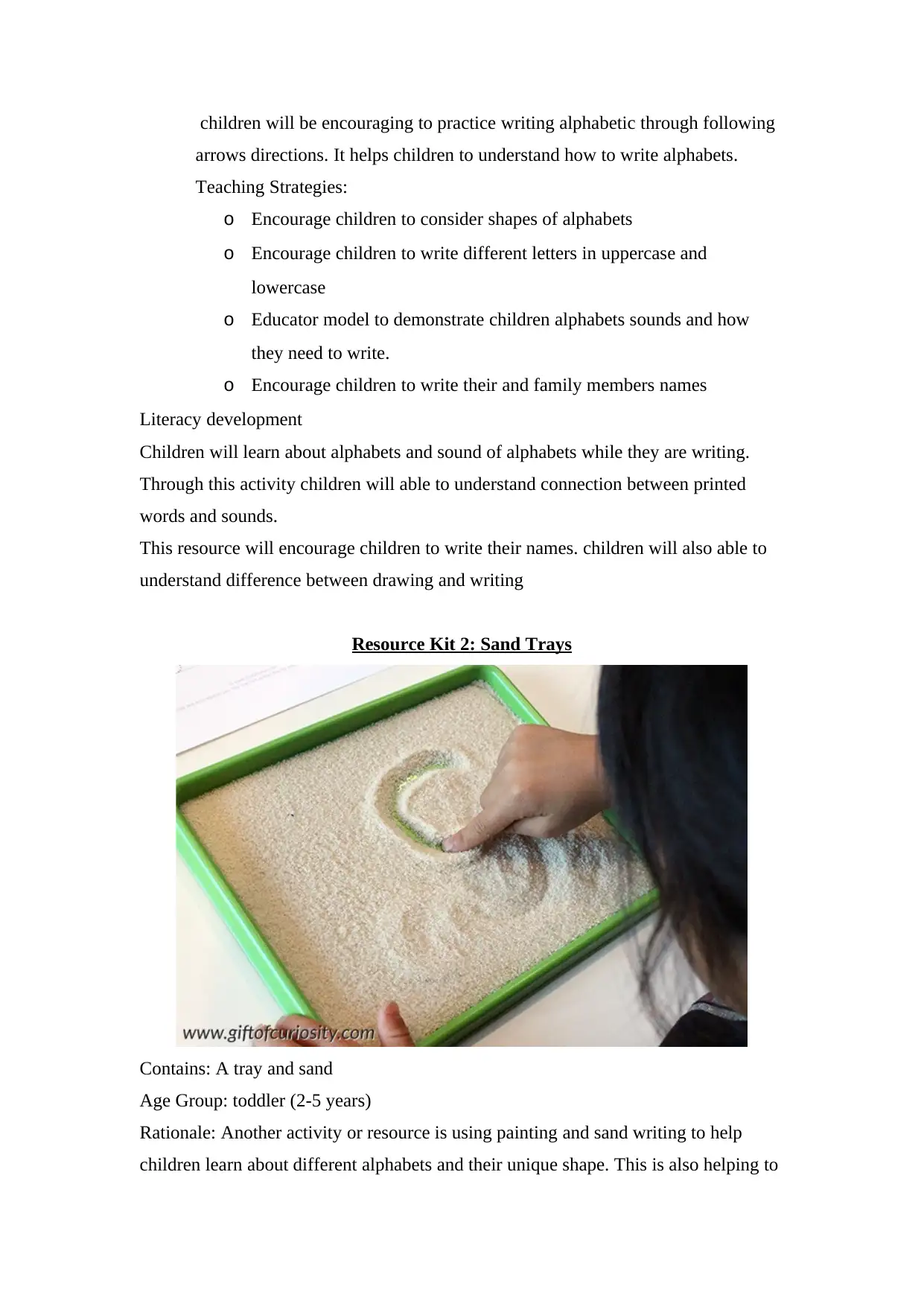
children will be encouraging to practice writing alphabetic through following
arrows directions. It helps children to understand how to write alphabets.
Teaching Strategies:
o Encourage children to consider shapes of alphabets
o Encourage children to write different letters in uppercase and
lowercase
o Educator model to demonstrate children alphabets sounds and how
they need to write.
o Encourage children to write their and family members names
Literacy development
Children will learn about alphabets and sound of alphabets while they are writing.
Through this activity children will able to understand connection between printed
words and sounds.
This resource will encourage children to write their names. children will also able to
understand difference between drawing and writing
Resource Kit 2: Sand Trays
Contains: A tray and sand
Age Group: toddler (2-5 years)
Rationale: Another activity or resource is using painting and sand writing to help
children learn about different alphabets and their unique shape. This is also helping to
arrows directions. It helps children to understand how to write alphabets.
Teaching Strategies:
o Encourage children to consider shapes of alphabets
o Encourage children to write different letters in uppercase and
lowercase
o Educator model to demonstrate children alphabets sounds and how
they need to write.
o Encourage children to write their and family members names
Literacy development
Children will learn about alphabets and sound of alphabets while they are writing.
Through this activity children will able to understand connection between printed
words and sounds.
This resource will encourage children to write their names. children will also able to
understand difference between drawing and writing
Resource Kit 2: Sand Trays
Contains: A tray and sand
Age Group: toddler (2-5 years)
Rationale: Another activity or resource is using painting and sand writing to help
children learn about different alphabets and their unique shape. This is also helping to
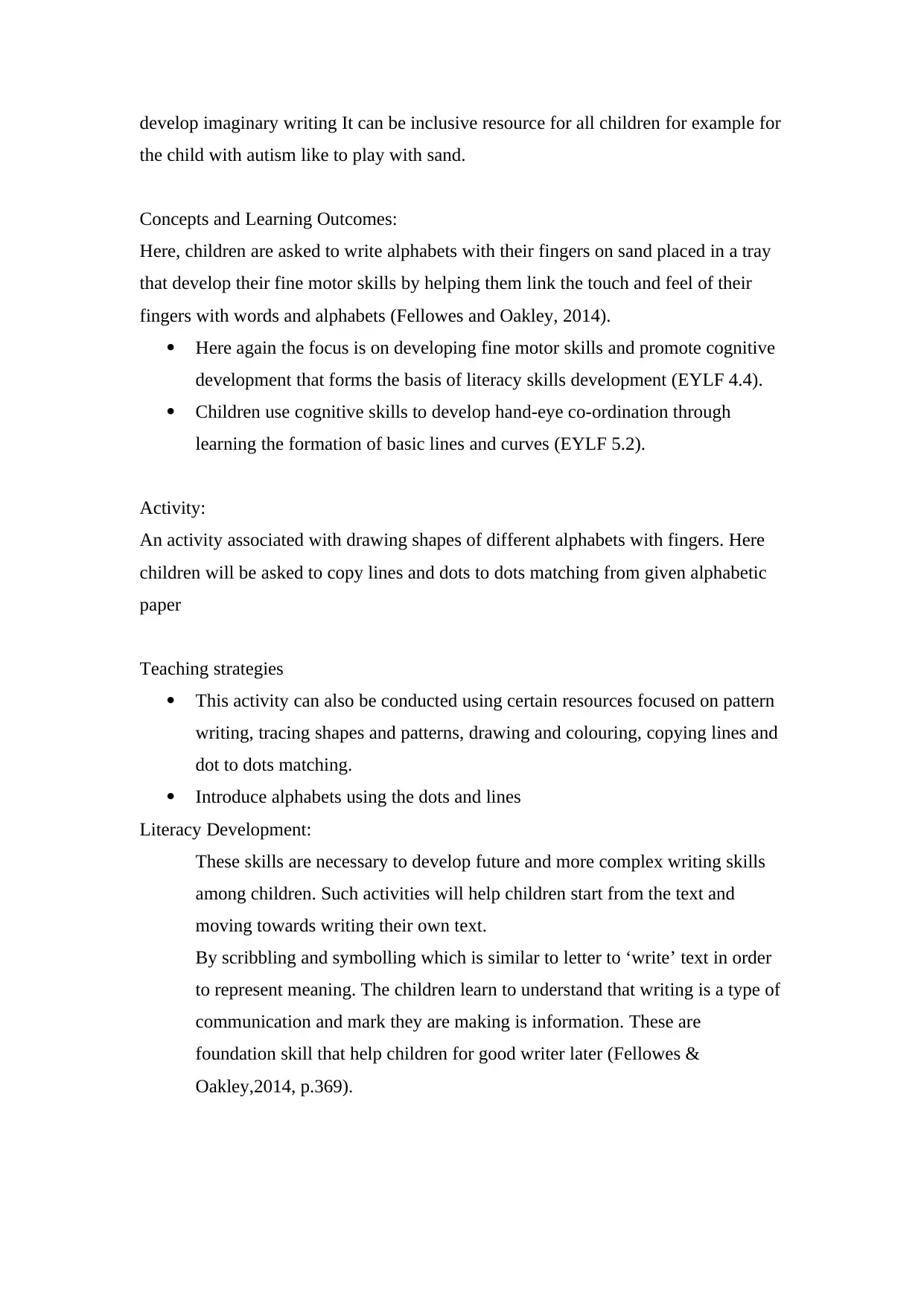
develop imaginary writing It can be inclusive resource for all children for example for
the child with autism like to play with sand.
Concepts and Learning Outcomes:
Here, children are asked to write alphabets with their fingers on sand placed in a tray
that develop their fine motor skills by helping them link the touch and feel of their
fingers with words and alphabets (Fellowes and Oakley, 2014).
Here again the focus is on developing fine motor skills and promote cognitive
development that forms the basis of literacy skills development (EYLF 4.4).
Children use cognitive skills to develop hand-eye co-ordination through
learning the formation of basic lines and curves (EYLF 5.2).
Activity:
An activity associated with drawing shapes of different alphabets with fingers. Here
children will be asked to copy lines and dots to dots matching from given alphabetic
paper
Teaching strategies
This activity can also be conducted using certain resources focused on pattern
writing, tracing shapes and patterns, drawing and colouring, copying lines and
dot to dots matching.
Introduce alphabets using the dots and lines
Literacy Development:
These skills are necessary to develop future and more complex writing skills
among children. Such activities will help children start from the text and
moving towards writing their own text.
By scribbling and symbolling which is similar to letter to ‘write’ text in order
to represent meaning. The children learn to understand that writing is a type of
communication and mark they are making is information. These are
foundation skill that help children for good writer later (Fellowes &
Oakley,2014, p.369).
the child with autism like to play with sand.
Concepts and Learning Outcomes:
Here, children are asked to write alphabets with their fingers on sand placed in a tray
that develop their fine motor skills by helping them link the touch and feel of their
fingers with words and alphabets (Fellowes and Oakley, 2014).
Here again the focus is on developing fine motor skills and promote cognitive
development that forms the basis of literacy skills development (EYLF 4.4).
Children use cognitive skills to develop hand-eye co-ordination through
learning the formation of basic lines and curves (EYLF 5.2).
Activity:
An activity associated with drawing shapes of different alphabets with fingers. Here
children will be asked to copy lines and dots to dots matching from given alphabetic
paper
Teaching strategies
This activity can also be conducted using certain resources focused on pattern
writing, tracing shapes and patterns, drawing and colouring, copying lines and
dot to dots matching.
Introduce alphabets using the dots and lines
Literacy Development:
These skills are necessary to develop future and more complex writing skills
among children. Such activities will help children start from the text and
moving towards writing their own text.
By scribbling and symbolling which is similar to letter to ‘write’ text in order
to represent meaning. The children learn to understand that writing is a type of
communication and mark they are making is information. These are
foundation skill that help children for good writer later (Fellowes &
Oakley,2014, p.369).

Digital technology teaching resource
Contains: Resources to be used will include story books, white board, projector,
laptop, digital format of the story and other associated technological devices
Rationale
Such methods will help in achieving the aim of making children effective
communicators and helping them express their ideas and make meaning of resources
available to them in the form of books, media, and technological sources thereby
developing investigative ideas and representation skills to present their thinking and
views on different subjects and issues.
Concepts and Learning Outcomes:
Children will develop knowledge in technologies and engage them and make
meaning.
Children will develop their knowledge and skill in storytelling.
The strategies will help the educators to explore different aspects of teaching
multi-literacies, code breaker, functional user, meaning maker, critical
analyser and transformer.
Children become effective communicators through use of information and
communication technologies to access information, investigate ideas and
represented their thinking (EYLF 5.5).
The resource is also associated with outcome 4 of early years learning
framework where children are expected to become confident and involved
learning as they start connecting with people, places and technologies along
with the natural things and resources (EYLF 4.4).
Contains: Resources to be used will include story books, white board, projector,
laptop, digital format of the story and other associated technological devices
Rationale
Such methods will help in achieving the aim of making children effective
communicators and helping them express their ideas and make meaning of resources
available to them in the form of books, media, and technological sources thereby
developing investigative ideas and representation skills to present their thinking and
views on different subjects and issues.
Concepts and Learning Outcomes:
Children will develop knowledge in technologies and engage them and make
meaning.
Children will develop their knowledge and skill in storytelling.
The strategies will help the educators to explore different aspects of teaching
multi-literacies, code breaker, functional user, meaning maker, critical
analyser and transformer.
Children become effective communicators through use of information and
communication technologies to access information, investigate ideas and
represented their thinking (EYLF 5.5).
The resource is also associated with outcome 4 of early years learning
framework where children are expected to become confident and involved
learning as they start connecting with people, places and technologies along
with the natural things and resources (EYLF 4.4).
Paraphrase This Document
Need a fresh take? Get an instant paraphrase of this document with our AI Paraphraser
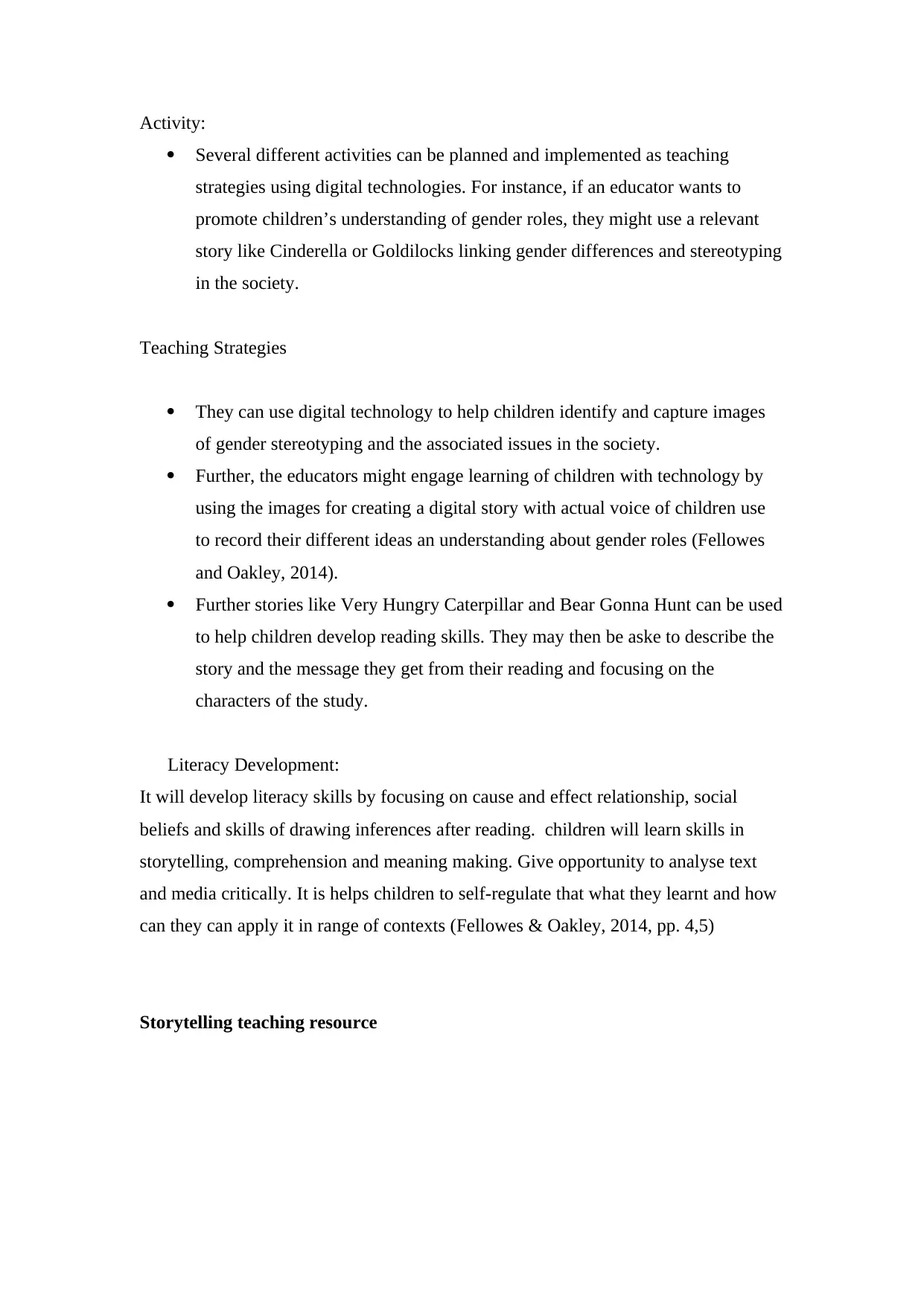
Activity:
Several different activities can be planned and implemented as teaching
strategies using digital technologies. For instance, if an educator wants to
promote children’s understanding of gender roles, they might use a relevant
story like Cinderella or Goldilocks linking gender differences and stereotyping
in the society.
Teaching Strategies
They can use digital technology to help children identify and capture images
of gender stereotyping and the associated issues in the society.
Further, the educators might engage learning of children with technology by
using the images for creating a digital story with actual voice of children use
to record their different ideas an understanding about gender roles (Fellowes
and Oakley, 2014).
Further stories like Very Hungry Caterpillar and Bear Gonna Hunt can be used
to help children develop reading skills. They may then be aske to describe the
story and the message they get from their reading and focusing on the
characters of the study.
Literacy Development:
It will develop literacy skills by focusing on cause and effect relationship, social
beliefs and skills of drawing inferences after reading. children will learn skills in
storytelling, comprehension and meaning making. Give opportunity to analyse text
and media critically. It is helps children to self-regulate that what they learnt and how
can they can apply it in range of contexts (Fellowes & Oakley, 2014, pp. 4,5)
Storytelling teaching resource
Several different activities can be planned and implemented as teaching
strategies using digital technologies. For instance, if an educator wants to
promote children’s understanding of gender roles, they might use a relevant
story like Cinderella or Goldilocks linking gender differences and stereotyping
in the society.
Teaching Strategies
They can use digital technology to help children identify and capture images
of gender stereotyping and the associated issues in the society.
Further, the educators might engage learning of children with technology by
using the images for creating a digital story with actual voice of children use
to record their different ideas an understanding about gender roles (Fellowes
and Oakley, 2014).
Further stories like Very Hungry Caterpillar and Bear Gonna Hunt can be used
to help children develop reading skills. They may then be aske to describe the
story and the message they get from their reading and focusing on the
characters of the study.
Literacy Development:
It will develop literacy skills by focusing on cause and effect relationship, social
beliefs and skills of drawing inferences after reading. children will learn skills in
storytelling, comprehension and meaning making. Give opportunity to analyse text
and media critically. It is helps children to self-regulate that what they learnt and how
can they can apply it in range of contexts (Fellowes & Oakley, 2014, pp. 4,5)
Storytelling teaching resource
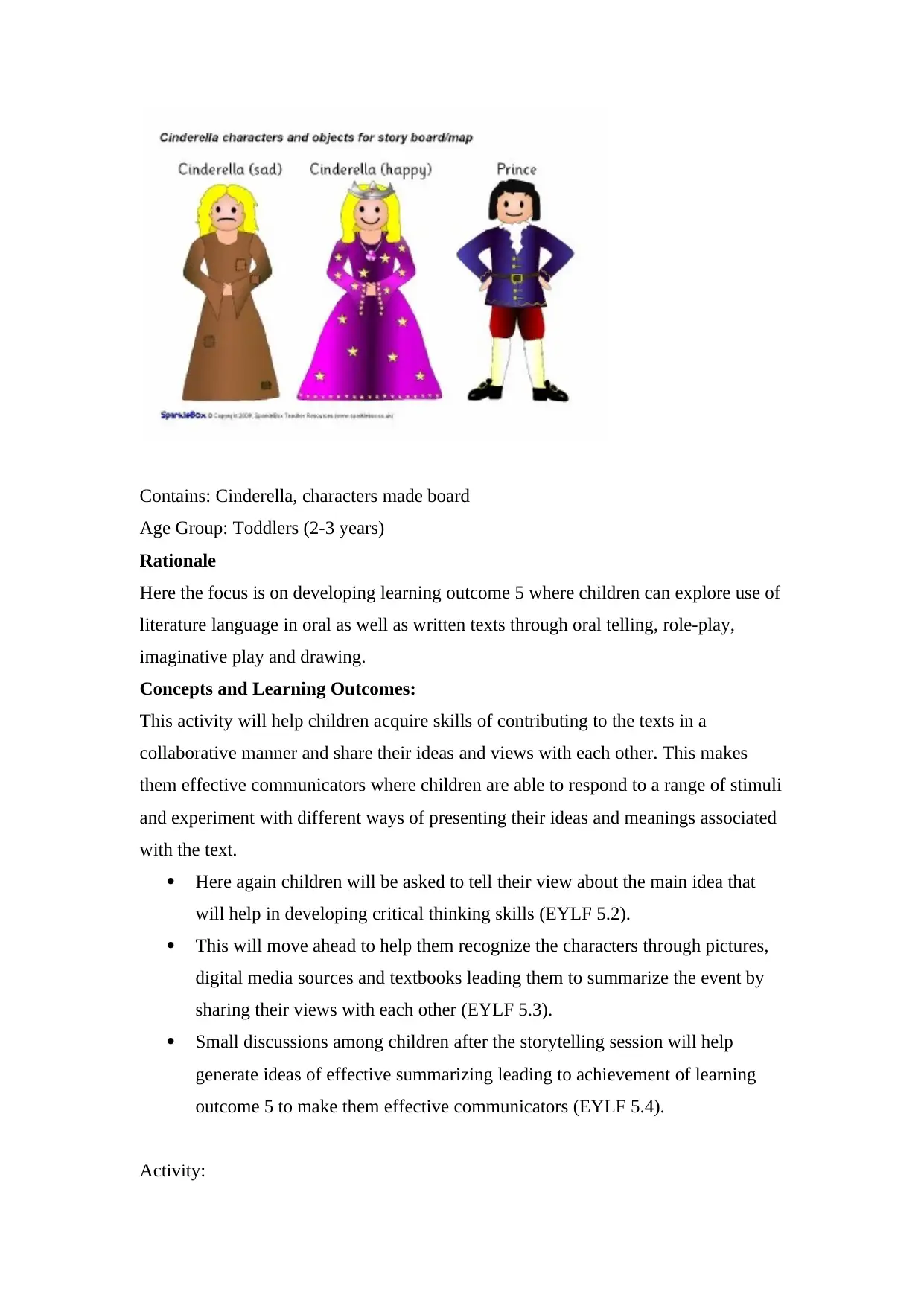
Contains: Cinderella, characters made board
Age Group: Toddlers (2-3 years)
Rationale
Here the focus is on developing learning outcome 5 where children can explore use of
literature language in oral as well as written texts through oral telling, role-play,
imaginative play and drawing.
Concepts and Learning Outcomes:
This activity will help children acquire skills of contributing to the texts in a
collaborative manner and share their ideas and views with each other. This makes
them effective communicators where children are able to respond to a range of stimuli
and experiment with different ways of presenting their ideas and meanings associated
with the text.
Here again children will be asked to tell their view about the main idea that
will help in developing critical thinking skills (EYLF 5.2).
This will move ahead to help them recognize the characters through pictures,
digital media sources and textbooks leading them to summarize the event by
sharing their views with each other (EYLF 5.3).
Small discussions among children after the storytelling session will help
generate ideas of effective summarizing leading to achievement of learning
outcome 5 to make them effective communicators (EYLF 5.4).
Activity:
Age Group: Toddlers (2-3 years)
Rationale
Here the focus is on developing learning outcome 5 where children can explore use of
literature language in oral as well as written texts through oral telling, role-play,
imaginative play and drawing.
Concepts and Learning Outcomes:
This activity will help children acquire skills of contributing to the texts in a
collaborative manner and share their ideas and views with each other. This makes
them effective communicators where children are able to respond to a range of stimuli
and experiment with different ways of presenting their ideas and meanings associated
with the text.
Here again children will be asked to tell their view about the main idea that
will help in developing critical thinking skills (EYLF 5.2).
This will move ahead to help them recognize the characters through pictures,
digital media sources and textbooks leading them to summarize the event by
sharing their views with each other (EYLF 5.3).
Small discussions among children after the storytelling session will help
generate ideas of effective summarizing leading to achievement of learning
outcome 5 to make them effective communicators (EYLF 5.4).
Activity:
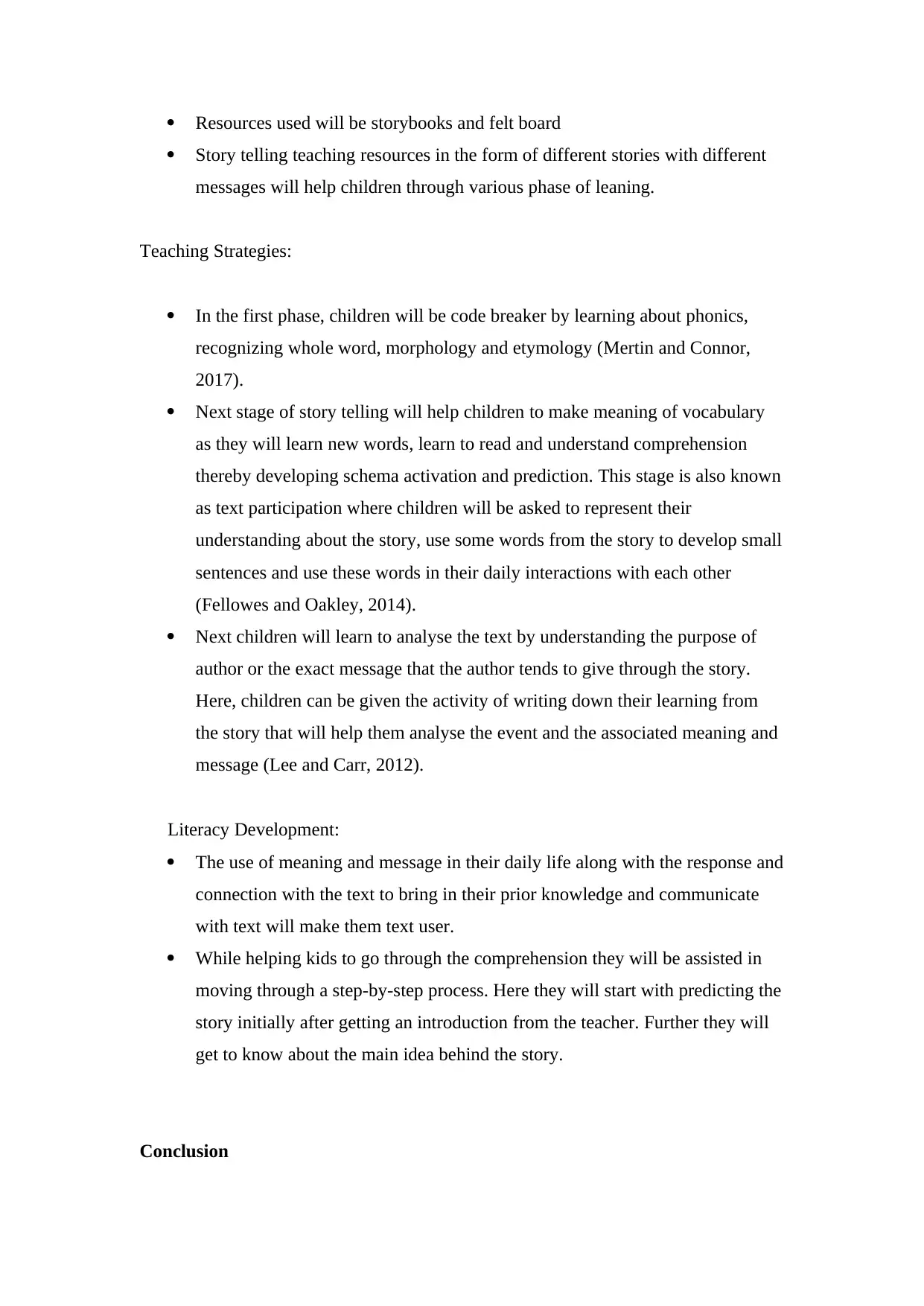
Resources used will be storybooks and felt board
Story telling teaching resources in the form of different stories with different
messages will help children through various phase of leaning.
Teaching Strategies:
In the first phase, children will be code breaker by learning about phonics,
recognizing whole word, morphology and etymology (Mertin and Connor,
2017).
Next stage of story telling will help children to make meaning of vocabulary
as they will learn new words, learn to read and understand comprehension
thereby developing schema activation and prediction. This stage is also known
as text participation where children will be asked to represent their
understanding about the story, use some words from the story to develop small
sentences and use these words in their daily interactions with each other
(Fellowes and Oakley, 2014).
Next children will learn to analyse the text by understanding the purpose of
author or the exact message that the author tends to give through the story.
Here, children can be given the activity of writing down their learning from
the story that will help them analyse the event and the associated meaning and
message (Lee and Carr, 2012).
Literacy Development:
The use of meaning and message in their daily life along with the response and
connection with the text to bring in their prior knowledge and communicate
with text will make them text user.
While helping kids to go through the comprehension they will be assisted in
moving through a step-by-step process. Here they will start with predicting the
story initially after getting an introduction from the teacher. Further they will
get to know about the main idea behind the story.
Conclusion
Story telling teaching resources in the form of different stories with different
messages will help children through various phase of leaning.
Teaching Strategies:
In the first phase, children will be code breaker by learning about phonics,
recognizing whole word, morphology and etymology (Mertin and Connor,
2017).
Next stage of story telling will help children to make meaning of vocabulary
as they will learn new words, learn to read and understand comprehension
thereby developing schema activation and prediction. This stage is also known
as text participation where children will be asked to represent their
understanding about the story, use some words from the story to develop small
sentences and use these words in their daily interactions with each other
(Fellowes and Oakley, 2014).
Next children will learn to analyse the text by understanding the purpose of
author or the exact message that the author tends to give through the story.
Here, children can be given the activity of writing down their learning from
the story that will help them analyse the event and the associated meaning and
message (Lee and Carr, 2012).
Literacy Development:
The use of meaning and message in their daily life along with the response and
connection with the text to bring in their prior knowledge and communicate
with text will make them text user.
While helping kids to go through the comprehension they will be assisted in
moving through a step-by-step process. Here they will start with predicting the
story initially after getting an introduction from the teacher. Further they will
get to know about the main idea behind the story.
Conclusion
Secure Best Marks with AI Grader
Need help grading? Try our AI Grader for instant feedback on your assignments.
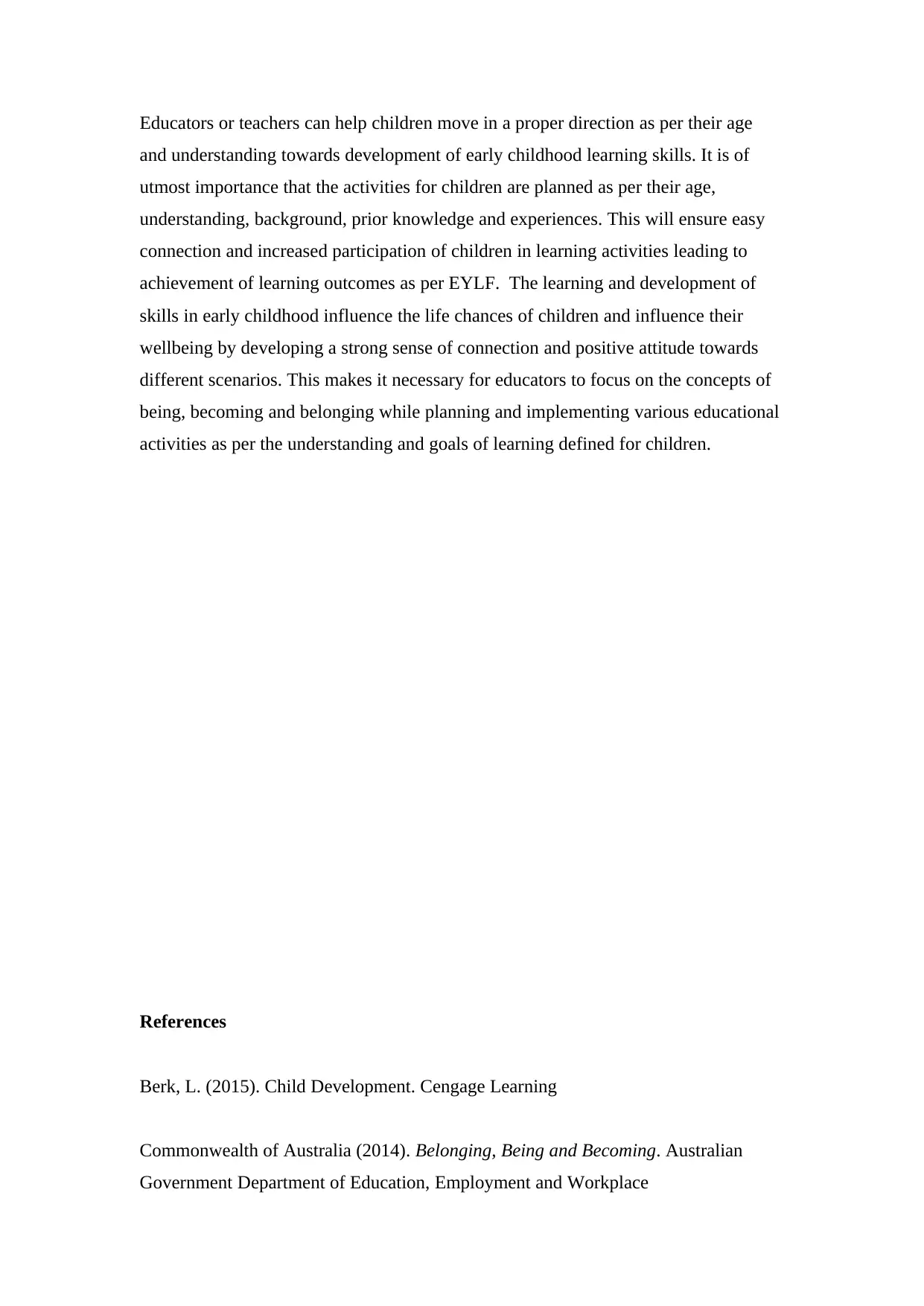
Educators or teachers can help children move in a proper direction as per their age
and understanding towards development of early childhood learning skills. It is of
utmost importance that the activities for children are planned as per their age,
understanding, background, prior knowledge and experiences. This will ensure easy
connection and increased participation of children in learning activities leading to
achievement of learning outcomes as per EYLF. The learning and development of
skills in early childhood influence the life chances of children and influence their
wellbeing by developing a strong sense of connection and positive attitude towards
different scenarios. This makes it necessary for educators to focus on the concepts of
being, becoming and belonging while planning and implementing various educational
activities as per the understanding and goals of learning defined for children.
References
Berk, L. (2015). Child Development. Cengage Learning
Commonwealth of Australia (2014). Belonging, Being and Becoming. Australian
Government Department of Education, Employment and Workplace
and understanding towards development of early childhood learning skills. It is of
utmost importance that the activities for children are planned as per their age,
understanding, background, prior knowledge and experiences. This will ensure easy
connection and increased participation of children in learning activities leading to
achievement of learning outcomes as per EYLF. The learning and development of
skills in early childhood influence the life chances of children and influence their
wellbeing by developing a strong sense of connection and positive attitude towards
different scenarios. This makes it necessary for educators to focus on the concepts of
being, becoming and belonging while planning and implementing various educational
activities as per the understanding and goals of learning defined for children.
References
Berk, L. (2015). Child Development. Cengage Learning
Commonwealth of Australia (2014). Belonging, Being and Becoming. Australian
Government Department of Education, Employment and Workplace
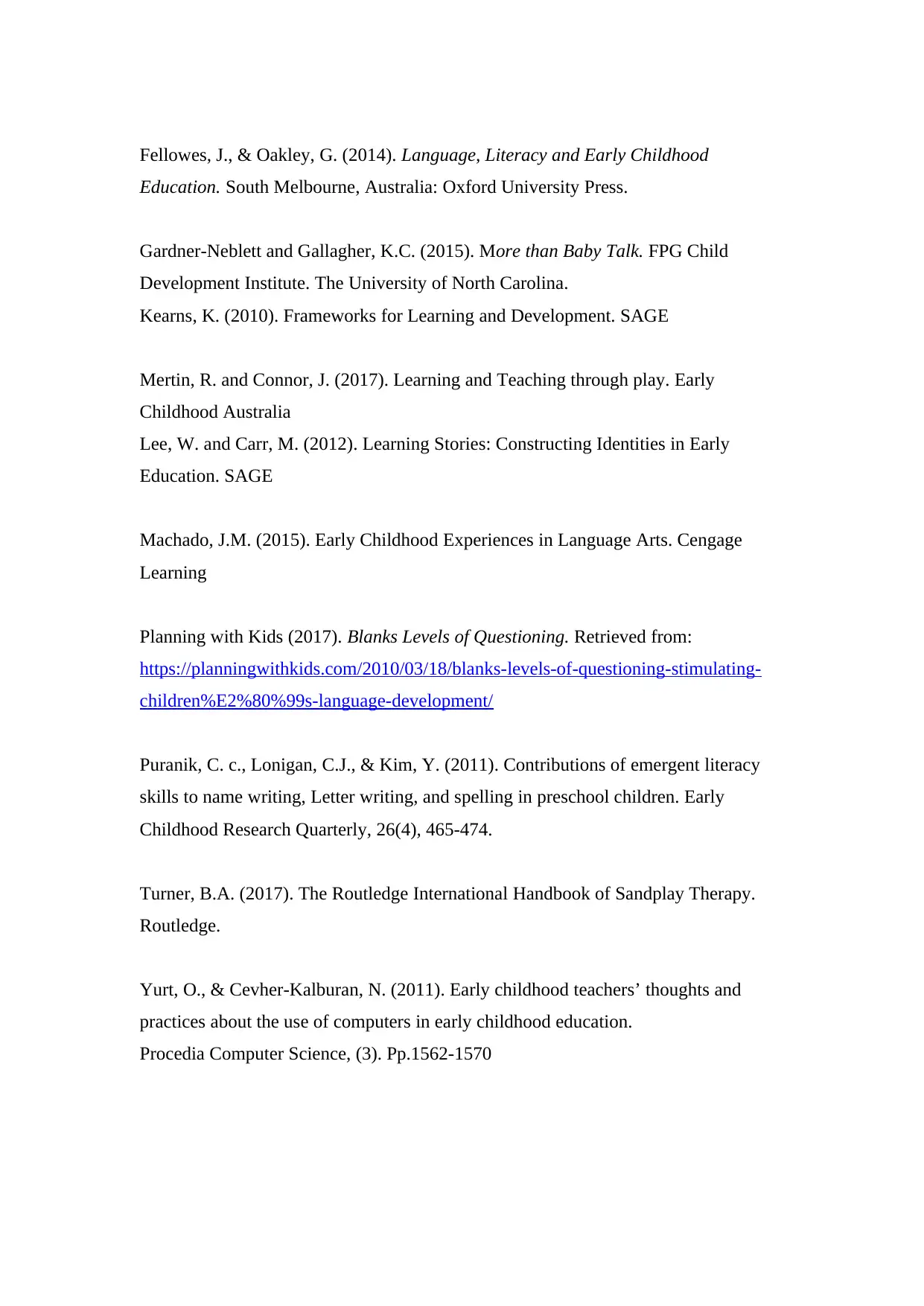
Fellowes, J., & Oakley, G. (2014). Language, Literacy and Early Childhood
Education. South Melbourne, Australia: Oxford University Press.
Gardner-Neblett and Gallagher, K.C. (2015). More than Baby Talk. FPG Child
Development Institute. The University of North Carolina.
Kearns, K. (2010). Frameworks for Learning and Development. SAGE
Mertin, R. and Connor, J. (2017). Learning and Teaching through play. Early
Childhood Australia
Lee, W. and Carr, M. (2012). Learning Stories: Constructing Identities in Early
Education. SAGE
Machado, J.M. (2015). Early Childhood Experiences in Language Arts. Cengage
Learning
Planning with Kids (2017). Blanks Levels of Questioning. Retrieved from:
https://planningwithkids.com/2010/03/18/blanks-levels-of-questioning-stimulating-
children%E2%80%99s-language-development/
Puranik, C. c., Lonigan, C.J., & Kim, Y. (2011). Contributions of emergent literacy
skills to name writing, Letter writing, and spelling in preschool children. Early
Childhood Research Quarterly, 26(4), 465-474.
Turner, B.A. (2017). The Routledge International Handbook of Sandplay Therapy.
Routledge.
Yurt, O., & Cevher-Kalburan, N. (2011). Early childhood teachers’ thoughts and
practices about the use of computers in early childhood education.
Procedia Computer Science, (3). Pp.1562-1570
Education. South Melbourne, Australia: Oxford University Press.
Gardner-Neblett and Gallagher, K.C. (2015). More than Baby Talk. FPG Child
Development Institute. The University of North Carolina.
Kearns, K. (2010). Frameworks for Learning and Development. SAGE
Mertin, R. and Connor, J. (2017). Learning and Teaching through play. Early
Childhood Australia
Lee, W. and Carr, M. (2012). Learning Stories: Constructing Identities in Early
Education. SAGE
Machado, J.M. (2015). Early Childhood Experiences in Language Arts. Cengage
Learning
Planning with Kids (2017). Blanks Levels of Questioning. Retrieved from:
https://planningwithkids.com/2010/03/18/blanks-levels-of-questioning-stimulating-
children%E2%80%99s-language-development/
Puranik, C. c., Lonigan, C.J., & Kim, Y. (2011). Contributions of emergent literacy
skills to name writing, Letter writing, and spelling in preschool children. Early
Childhood Research Quarterly, 26(4), 465-474.
Turner, B.A. (2017). The Routledge International Handbook of Sandplay Therapy.
Routledge.
Yurt, O., & Cevher-Kalburan, N. (2011). Early childhood teachers’ thoughts and
practices about the use of computers in early childhood education.
Procedia Computer Science, (3). Pp.1562-1570
1 out of 12
Related Documents
Your All-in-One AI-Powered Toolkit for Academic Success.
+13062052269
info@desklib.com
Available 24*7 on WhatsApp / Email
![[object Object]](/_next/static/media/star-bottom.7253800d.svg)
Unlock your academic potential
© 2024 | Zucol Services PVT LTD | All rights reserved.





